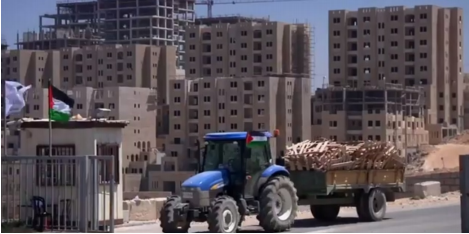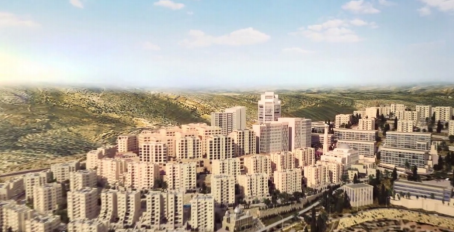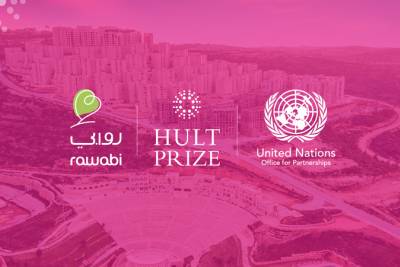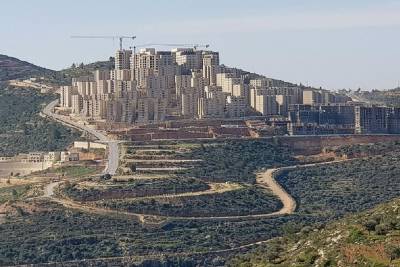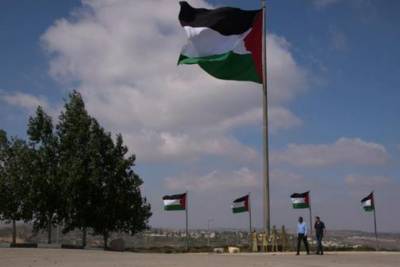New Palestinian urban identity in Rawabi
CanThink Blog - Dothan Halevy - The new Palestinian city near Ramallah Rawabi is seen by entrepreneurs as a golden opportunity to raise the Palestinian urban history to new path, on its way to the future state. City builders seek to sever the premier living experience in the traditional Palestinian countryside and cities and never load it with the conflict concepts.
Last weekend it was decided to name the square which greets visitors at the entrance gate of the new Palestinian city with the name of the city itself - "Rawabi Square” Those who chose this name for the project, while rejecting other names that were suggested such "a - Zeituna" (olive
tree) and “Al – Kroom” (Vineyards), were about a hundred thousand visitors at Face book page, which is updated every week about construction development. This vote, the first of the three, is part of a careful comparative marketing construction project much more glamorous aura than a purely engineering enterprise, through a website, a Face book page and a variety of media reviews. Rawabi, under s its slogan is supposed to be a place to "live, work and grow" in a new life style for a future Palestinian state. Stylish names of the city were designed therefore, as an important factor in determining the future character of the city.
Aalongside the demographic and political aspects, we have to understand that the construction of the new city is based on the Palestinian urban history since 1948. War cut off a layer of Palestinian urban elite, including Jerusalem, Jaffa, Haifa, Ramleh and Tiberias. Inside Israel, the Arab residents of the few remaining cities or those who were moved to those cities as refugees were transformed into a low minority status. In addition, after 1948 the Jewish towns did not attract the Arab villagers, thus leading to municipal services to access into the villages and to a
massive increase in their population. The State of Israel has with time recognized some of these villages as “Cities" even though they lacked any civil social or economic nature. That was how Arab villages which stayed within Israeli territory assumed the current status as a kind of urban Village or rural Town.
One of the common arguments against the Israeli government policy, in relation to the Arab population, is that it adopted an open and clear trend of "de - urbanization", or prevention of normal urbanization which was adopted for the country's Jewish citizens only. Nevertheless, after 1948, even in the West Bank, there were two obstacles against the development of the urban environment and civil society. The first was that the largest refugee population gradually relied on major cities. The second was the policy of deliberate neglect on the part of the Hashemite regime, who ruled the West Bank from 1948 to 1967, where this neglect was meant to weaken the West Bank cities and empower cities in Transjordan. Thus, since 1948 urbanization and urban development in Palestinian society both in Israel and the West Bank faced both, huge difficulties and bumps.
This concept has developed in recent years, whereby stronger Palestinian narrative discourse asked to change the refugee’s wishes to return to the home village and lemon tree orchards. The current Village experience and the romanticizing effort of the allegedly Palestinian past, built a memory whereby Palestinian society was rural only, when in fact urban style has been forgotten or evaded.
The new city of Rawabi under construction can be conceived as part of the attempt to open a new Palestinian urban history. Very wisely the initiator of the project, the Palestinian businessman Bashar al - Masri, never tried to recreate the Arab Jaffa, or reproduce Ramallah or even build a Palestinian Manhattan. Since Rawabi is a pre planned city from scratch up, it is fair to assume that Mr. Masri got the inspiration from the Israeli Modi'in when he decided to establish a city for the current middle-class generation of young Palestinian families who see the future of their children in a modern Palestinian state.
Realizing that names and terminology are not only derived from reality but can even shape this reality, so he sought to give the city a character expressed by the names he chose for sections and neighborhoods of the city. Palestinians have learned well from their Jewish neighbors that the naming process is a political action in all respects, hence the obligation to invest in much thought and pondering when picking those names.
Al - Masri selected a special path to tread on. By merely choosing the name "Rawabi” ("hills"), he actually rejected other proposals as "Arafat city” or “Jihad City”, and eventually he created a relation between the city symbolizing a new creation, and the typical topography of the region.
City neighborhoods were also given unique names, maybe even a little strange, taken from the ancient Semitic languages like: "Makmaata" (rock), "Suwan" (flint), "Ikshaf" (magic, witchcraft) and "Tersah”(happiness, amusement). Choice to pick unfamiliar languages, such as Acadian and also Aramaic - is intended to symbolize the city's connection to the Canaanite Palestinian past. The Palestinian claim that the origin of the Palestinian go back to the Canaanites, a fact intended to dispute the claim of the Jewish historical connection with the children of Jacob, (Israelites) who lived in the area, highlights the seniority of the Palestinians to the land. In light of Rawabi geographical location, adjacent to the settlements of Halamish (Neve Nectar), Ateret (Crown), Ofra and Beit Eel, whose names are derived from the old biblical sites, the new city debate reflects an aggressive tone.
Other neighborhoods of Rawabi were given names such as: "Wirwar" which is the Arabic name of the local bee- eater bird and “Dalim” after one of the most important Arab tribes of Syria and Iraq. The various models of the buildings in Rawabi had Arabic names too, like "Marmar" (alabaster), "Ballour" (Crystal), "Zan" (beech) or "Watar" (musical instrument chord). Arab names were also selected to emphasize the trend to link the city to the existing nature that surrounds it, and the characteristics of Arab roots, while avoiding direct connection to the symbols of the Palestinian struggle of the last few generations. At least for now it seems that these names are favored over “Al Shahadeh” Boulevard or Square, which is common in other cities and across past events and personalities of modern Palestinian history.
By the end of the year, the first 600 families are expected to move in two neighborhoods of Rawabi "Al Suwan" and "Makmata” This will be an important opportunity to raise the Palestinian urban history and experience to new path and level, on the way to a future state. Developers of Rawabi strongly believe that in order for this to materialize they must disconnect the new Rawabi living experience from the past traditional Palestinian cities’ as well as dropping the charged concepts of the conflict. Time will tell whether the mild and polite terms of the various parts of the city will indeed help in creating a new Palestinian identity.
To view original article, Click Here.

